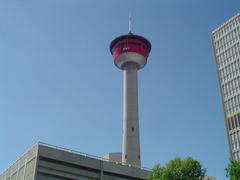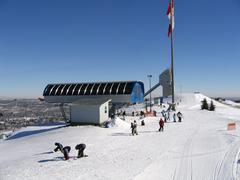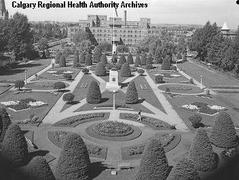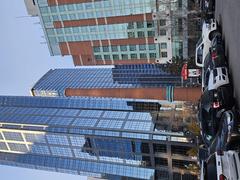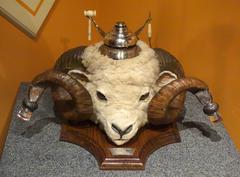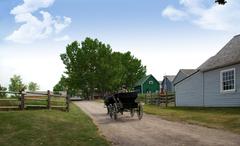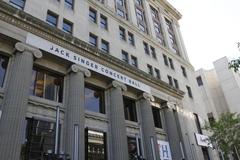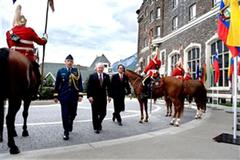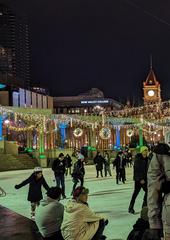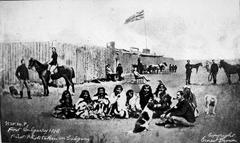Edworthy Park Calgary: Visiting Hours, Tickets, and Attractions Guide
Date: 03/07/2025
Introduction: History and Significance
Edworthy Park is a cornerstone of Calgary’s urban landscape—a vibrant green space that bridges ecological diversity with deep Indigenous and settler roots. Located along the southern bank of the Bow River in southwest Calgary, the park preserves remnants of Indigenous habitation dating back thousands of years, including stone circles and tools, alongside evidence of settler farming, quarrying, and early industrial activity. Today, Edworthy Park serves as both a recreational haven and a living archive, reflecting Calgary’s layered past and ongoing community engagement (Calgary Historical Sites; Wikipedia).
Accessible year-round with free admission, Edworthy Park offers expansive trails, unique Douglas-fir forests, rich wildlife, and a multitude of amenities. Its role in ongoing archaeological research and public education, particularly through the University of Calgary’s Public Archaeology Program, highlights the park’s enduring relevance as both a natural sanctuary and a cultural touchstone (UCalgary Public Archaeology Program).
This guide delivers a detailed look at Edworthy Park’s history, features, visiting information, and expert tips to help you plan and enrich your visit.
Contents
- Introduction
- Indigenous Presence and Archaeological Significance
- Early European Settlement and the Edworthy Family
- Quarrying and Industrial Development
- Park Formation and Land Acquisition
- Ecological and Cultural Features
- Visiting Information
- Hours and Admission
- Accessibility
- Directions and Parking
- Amenities
- Guided Tours and Events
- Nearby Attractions
- Preservation and Community Engagement
- Frequently Asked Questions (FAQ)
- Plan Your Visit
- Sources
Indigenous Presence and Archaeological Significance
Edworthy Park’s story begins thousands of years ago. Archaeological surveys and ongoing excavations, notably by the University of Calgary, have revealed bison bones, stone tools, and ceremonial stone circles, illustrating the area’s profound significance to Indigenous peoples (News Minimalist). Artifacts such as Plains Side-Notched projectile points indicate habitation during the Late Period (approximately 550–250 years ago), while material evidence suggests even older human activity (Calgary Parks Archaeology PDF).
The land—part of Treaty 7 territory—has supported Indigenous communities for millennia, providing resources for hunting, gathering, and ceremonial practices. Ongoing research, undertaken in partnership with Indigenous elders and youth, ensures that cultural protocols are honored and that contemporary narratives are included in site interpretation (Antiquity Archive).
Early European Settlement and the Edworthy Family
The park derives its name from Thomas Edworthy, an English immigrant who arrived in Calgary in 1883. He established market gardens on the land, notably cultivating the “Shaganappi spud,” and built relationships with the local Tsuut’ina Nation, employing Indigenous laborers. The Edworthy family also operated sandstone quarries, contributing to Calgary’s architectural development (Wikipedia; Calgary Parks Archaeology PDF).
After Thomas’s death in 1904, his wife Mary managed the estate until her passing in 1934. Their legacy is embedded in the park’s name and the preservation of its historical landscapes.
Quarrying and Industrial Development
In the early 20th century, Edworthy Park became an industrial hub, with sandstone quarries and the Brickburn community’s brickworks fueling Calgary’s construction boom. Scottish stonemasons and entrepreneurs like William John Tregillus contributed to the city’s growth, though the brickworks closed following economic downturns (Calgary Parks Archaeology PDF). Remnants of this industrial past, such as pressed bricks and home foundations, remain visible in the park today.
Park Formation and Land Acquisition
The transformation from industrial and agricultural land to public parkland began in 1962, when the City of Calgary acquired the area for recreational use. Part of the land was also donated by William Pearce, a federal surveyor and park advocate. Today, Edworthy Park spans approximately 1.27 square kilometers and forms an integral part of Calgary’s Bow River pathway system (Wikipedia).
Ecological and Cultural Features
Edworthy Park’s landscape combines riparian woodlands, grasslands, and a rare stand of Douglas-fir trees—some over 400 years old (Wikipedia). These habitats support diverse wildlife, including birds (woodpeckers, chickadees, warblers), squirrels, hares, and deer. The park’s natural features are complemented by historical artifacts, interpretive signage, and ongoing archaeological digs, offering a tangible connection to Calgary’s past (News Minimalist).
Visiting Information
Hours and Admission
- Open daily, year-round: 5:00 AM to 11:00 PM
- Admission: Free; no tickets required (HelloTravel)
Accessibility
- Paved and gravel trails are accessible for wheelchairs and strollers
- Accessible washrooms and picnic areas
Directions and Parking
- South Entrance: 5050 Spruce Dr. S.W.
- North Entrance: Accessible via Shaganappi Trail and 16th Ave NW
- Ample parking at both entrances; paid parking may be implemented at the north lot in 2025 (City of Calgary’s Edworthy Park page)
- Calgary Transit bus routes 6 and 16 serve nearby stops
- Extensive bike path connections
Amenities
- Washrooms (seasonal, accessible)
- Multiple picnic sites (reservable and first-come, first-served)
- Covered shelters, firepits, BBQ stands
- Inclusive playgrounds and drinking water stations
- Dog-friendly zones (on-leash and off-leash areas)
- No on-site food vendors; Angel’s Café is located at the north end
Guided Tours and Events
- Seasonal guided archaeology tours offered by the University of Calgary (UCalgary Public Archaeology Program)
- Community events, clean-ups, and educational workshops
- Check the City of Calgary and university websites for schedules
Nearby Attractions
- Shaganappi Point Golf Course
- Bow River Pathway (connects to other parks)
- Nose Hill Park (another key archaeological and natural site)
Preservation and Community Engagement
Public advocacy has played a pivotal role in preserving Edworthy Park, notably when plans for a freeway extension through the park were abandoned following strong community opposition in the 1990s (Wikipedia). Ongoing stewardship combines archaeological research, Indigenous leadership, and public education to protect the park’s cultural and natural resources (Antiquity Archive).
Frequently Asked Questions (FAQ)
Q: What are Edworthy Park’s visiting hours?
A: Daily, 5:00 AM to 11:00 PM, year-round.
Q: Is there an entry fee?
A: No, the park is free and open to the public.
Q: Are pets allowed?
A: Yes, with leash requirements except in designated off-leash areas.
Q: Is the park accessible for people with disabilities?
A: Yes, paved trails and accessible facilities are provided.
Q: Are guided tours available?
A: Yes, seasonally through the University of Calgary’s Public Archaeology Program.
Q: How do I reserve a picnic shelter?
A: Reservations can be made online via the City of Calgary’s website.
Q: Is parking free?
A: Currently yes, but paid parking may be introduced at the north lot in 2025.
Plan Your Visit
Edworthy Park welcomes visitors of all interests—from outdoor adventurers and families to history buffs and students. To enhance your experience:
- Download the Audiala app for interactive maps, audio tours, and event updates
- Reserve picnic shelters in advance during peak season
- Check weather and trail conditions before your visit
- Respect wildlife and archaeological sites—leave no trace
For detailed, current information, visit the official City of Calgary Edworthy Park page and the University of Calgary Public Archaeology Program.
Key Visitor Information Recap
- Location: Southwest Calgary, Bow River
- Hours: 5:00 AM – 11:00 PM, daily
- Admission: Free
- Accessibility: Wheelchair-accessible trails and amenities
- Parking: Multiple lots; paid parking possible at north lot from 2025
- Contact: City of Calgary’s Edworthy Park page
Edworthy Park offers a unique opportunity to experience Calgary’s natural beauty, layered history, and vibrant community spirit—all within an accessible, welcoming environment. Whether you’re hiking, picnicking, cycling, or learning about the region’s ancient cultures, the park stands as a testament to Calgary’s commitment to preservation and public engagement (Visit Calgary; Antiquity Archive).
Sources
- Calgary Historical Sites
- Wikipedia: Edworthy Park
- HelloTravel: Edworthy Park
- Visit Calgary: 10 Must-Do Summer Experiences in Calgary
- University of Calgary Public Archaeology Program
- Antiquity Archive: Calgary Archaeology Initiatives
- News Minimalist: UCalgary Students Excavate Edworthy Park
